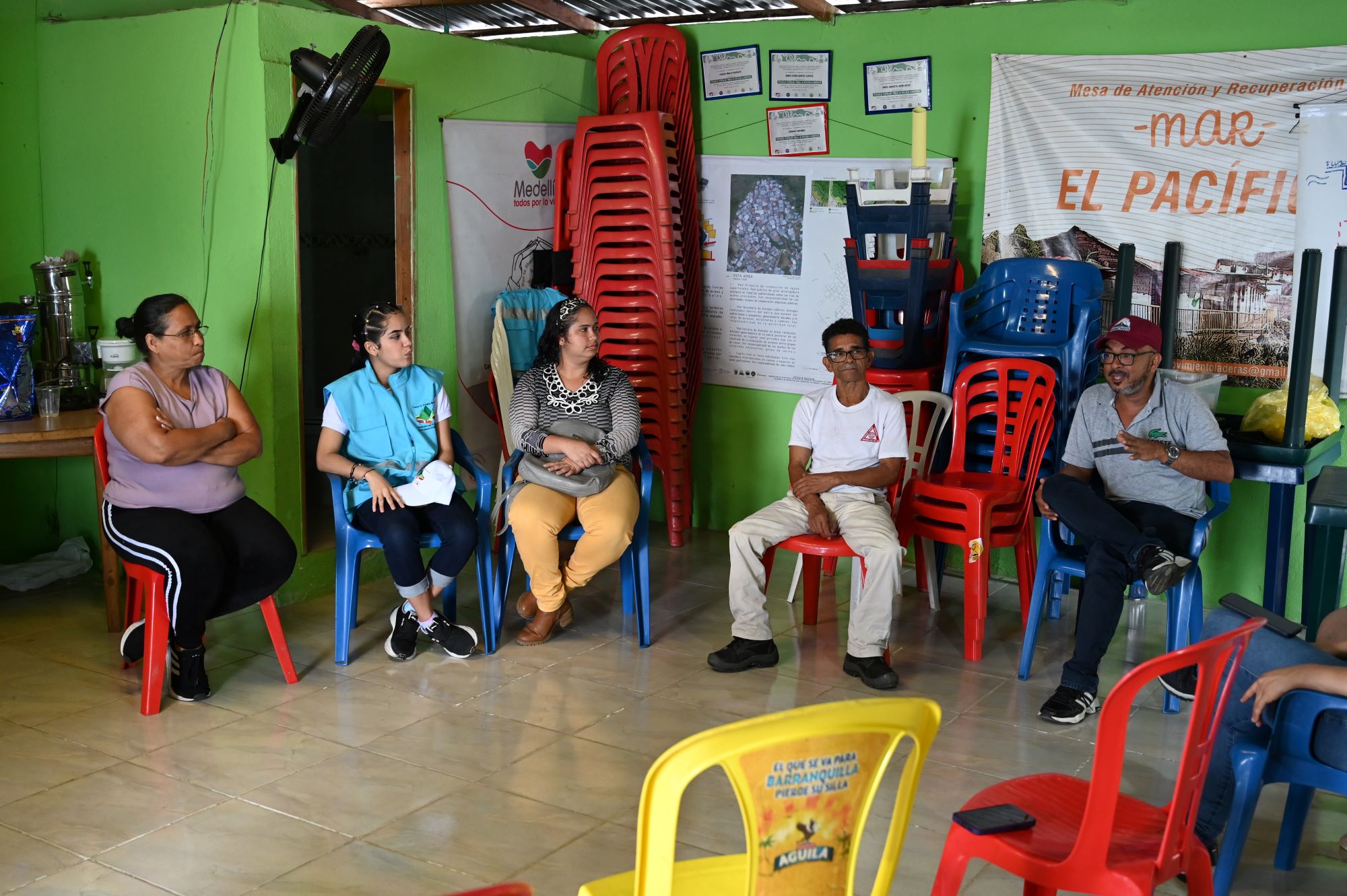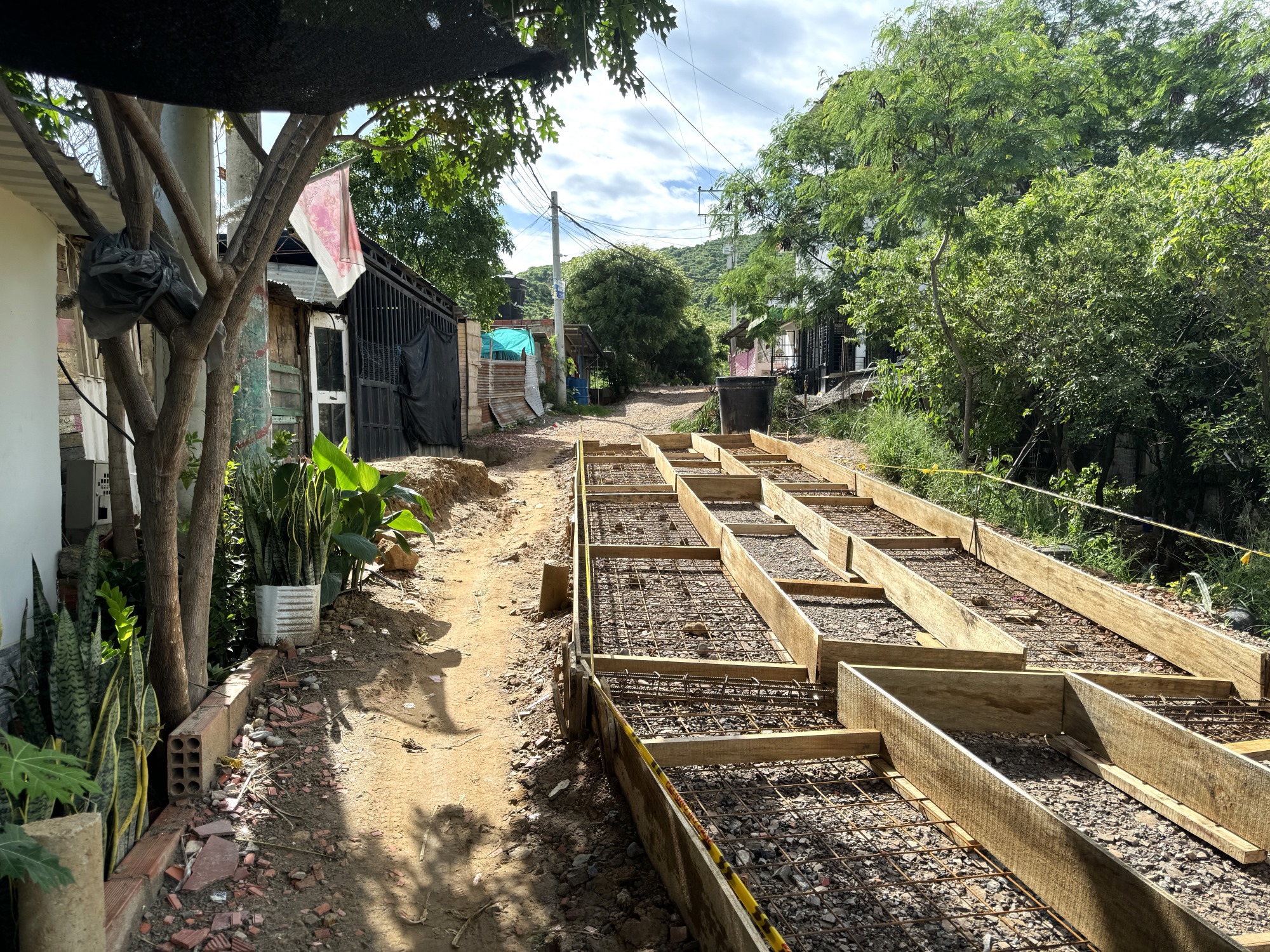Nearly 3 million Venezuelan migrants are living in Colombia.[1] Most are staying in dense, urban areas, where local communities are grappling with poverty and limited access to resources. Amidst these challenges, many Venezuelans struggle to integrate with their new communities and connect with neighbors.
The Acogida program, funded by the U.S. Department of State’s Bureau of Population, Refugees, and Migration, aims to bring Venezuelans and Colombians together in communities across the country while bridging gaps in aid. Acogida’s multilayered assistance centers around community needs and local leadership.
Our program team collaborates with Community Action Boards to foster collective action. Community Action Boards, the smallest unit of local governance in Colombia, are elected bodies that represent the interests of neighborhoods and small localities before the mayor’s office. Our teams talk with these members of the community every day to stay up to date on people’s needs and identify new opportunities.

Members of the Acogida committee and Community Action Board met in 13 de Noviembre to discuss progress on their trash collection initiative.
Understanding the authority, agency, and respect Community Action Boards hold, we work with them to form a subgroup in each neighborhood made up of Colombians and Venezuelans. The working group, called an “Acogida committee,” shares insight on community matters and what resources they need. This invites Venezuelans to be part of their local decision-making body and feel more integrated in community matters.
Acogida committees are tasked with creating the spaces and resources they need to lift themselves up or feel more at home through “community development initiatives.” The committees brainstorm a project that they would like to undertake in their community. These projects can be a mural, a place to gather and socialize, a community resource, and more. Our team members, including an engineer, help them decide on a project, design it, and present it to the municipal government for approval.
We then provide a grant to pay for materials and guide the committees through logistics. However, it’s up to the community groups to find contractors and oversee the projects. In the end, the communities own their projects and drive them forward.

In Nueva Colombia, Barranquilla, we provided a grant to build a roof over the local schoolyard to protect children from the weather and accommodate community gatherings like meetings, theater, and more.
“The initiatives can take many forms, as long as communities come to an agreement that the project they choose addresses the most pressing problem and it’s the best feasible solution,” said Juan Pablo Franco, our country director for Colombia.
Since 2021, we have supported 68 initiatives in 25 neighborhoods across Colombia. On average, projects cost $4,700 each.
This hyper-local decision-making helps our team adapt programming to community needs while encouraging social cohesion among neighbors. By working across divides, our team helped build trust while funding and facilitating this collective action.
“Community feedback is one of the fundamental pillars for designing and technically implementing each of the development initiatives,” said Mónica Rengifo, our engineer on the program. “During participatory workshops, where the community raises and expresses all the ideas they have regarding the initiative, I help them refine and adjust their idea–always with the help of the Acogida committees–in order to make each initiative possible.”

Marga, a community leader in El Escobal, guided her community development initiative to supply their community center with furniture and equipment.
According to Jorge Mario Alzate, a regional manager for Acogida, “Our support strengthens local capacities, fosters collaboration between the Venezuelan migrant population and the host community, and strengthens community ties.” Our team also aims to be adaptive, he said. “Our support is continuous and collaborative, and evolves according to the needs of the community.”
All these decision points give people the opportunity to build their leadership skills and take up responsibility for community matters. “Being part of the committee has taught me many things. It has taught me to be unified with my neighbors, both Venezuelan and Colombian, as we are all working towards the same goal,” said Elesa, a committee member from Medellín.
When it comes time to decide on a project, the committee members have to ask themselves, “What makes a community feel like home?” or “What makes our community feel safe for everyone?”
For many, it is having spaces where everyone gathers, checks on each other, and gets to know one another.

Pictured here with the Blumont team, the Golondrinas Acogida committee decided to renovate their community center to better serve families in need.
In the Golondrinas neighborhood of Medellín, it’s a community center. High in the hills, towering over the city, the Golondrinas community center is a place for everyone. Children go there after school, neighbors share information, and families celebrate milestones.
In 2023, their Acogida committee–made up of longtime residents and newer Venezuelan migrants–chose to renovate the center’s dining area, kitchen, and lighting to ensure people had a place to eat free, hot meals.
“Who are we doing this for? For all the adults who are in a difficult situation. Not only for Colombian adults and children but for migrants as well,” said Juan Manuel, the committee head. Juan Manuel is a transplant in Medellín, having fled violence within the country decades ago. He knows what it feels like to be displaced and need support. “This place belongs to everyone,” he said.
However, community development initiatives are not limited to community centers or gathering spaces. Over the past three years, projects have ranged widely depending on each neighborhood’s needs. They consider aspects of life like transportation, access to services, safety, and even youth development.

A trash collection service via motorbike prevents traffic jams formerly caused by large garbage trucks in the hilly neighborhood of 13 de Noviembre.
The Acogida program has developed projects including public parks, community centers, supplies for schools and health clinics, bridges, roofs for schoolyards, lighting, roads, and more. Each one of the projects is a community-led solution that will bring people together while improving their day-to-day lives.
In the neighborhood of 13 de Noviembre, the community faced challenges given their location high in the mountains of Medellín. Trash trucks block the roads throughout the week, struggling to collect waste and creating endless traffic. With funding and support from Blumont, local leaders designed a trash collection service by motorbike, a nimbler vehicle that can handle the rollercoaster of hills. The service would also create jobs for people in the community.
“We know that we have overcome 50,000 potholes so that this could happen,” said James, vice president of the community action board for 13 de Noviembre. “Blumont gave us the news that this community effort is somehow possible. Suddenly, it brought us hope, and you always have to hope that some door is going to open and solve the problem… So now this door has been opened and we believe that it is the biggest one that could be opened for us.”
Many communities face infrastructure issues due to geography and poor resources. In La Esperanza, Cúcuta, frequent tropical rains wash out a steep road from the community’s center to people’s homes. The community members agreed upon building a 65-meter paved road with proper water drainage to make the upper parts of La Esperanza more accessible. Their initiative required specialized construction and adaptations to the climate, but it will make life easier.
“The people are very happy, here, down there, and in the next neighborhood,” said José, a resident of La Esperanza, pointing down the hill. “The whole community is throwing themselves into this and the road is already from here to down there, and all the way to the park.”

The residents of La Esperanza decided to pave a road in that connects sections of their neighborhood for better accessibility and drainage.
These infrastructure works make communities more sustainable to live in. They also create a sense of togetherness, whether for Colombians or newly arrived Venezuelan migrants. By deciding, designing, and building together, people can be proud of and feel rooted in their neighborhoods. The initiatives have also become a way for Venezuelans to contribute to their host communities and show their dedication. In Tulipanes, Jamundí, a group of Venezuelan women on the Acogida committee said their new project was a way to give back to the community for all they have done for newcomers.
Marga, a community leader in El Escobal, Cúcuta, said, “The most important part of working with the community is the unity, the teamwork that it requires and upholds.”
[1] https://www.unrefugees.org/news/colombia-s-refugee-crisis-and-integration-approach-explained/



